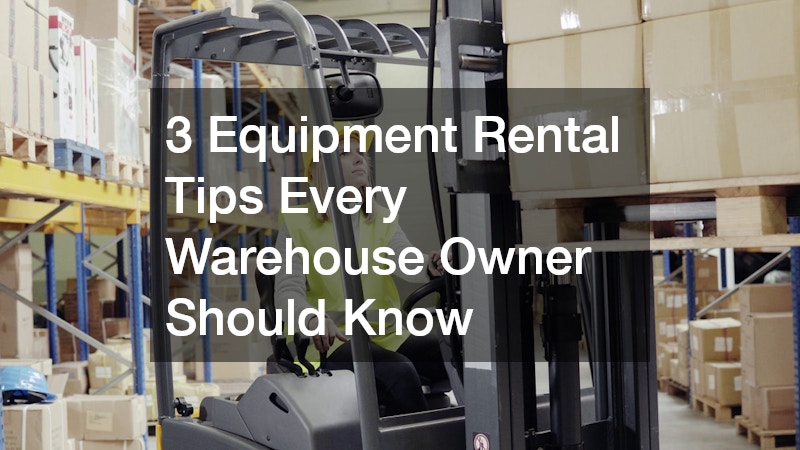Running a warehouse efficiently requires careful planning and strategic decision-making. From managing inventory to ensuring smooth operations, every aspect of a warehouse impacts productivity and profitability. One way warehouse owners can optimize operations is by leveraging equipment rental. It provides flexibility, cost savings, and access to the latest machinery without the burden of long-term ownership. By understanding best practices, managers can ensure they have the right tools for their specific operational needs while minimizing overhead costs.
Warehouse environments are dynamic, with shifting workloads, seasonal demand, and evolving safety requirements. Investing in the wrong machinery or overcommitting to purchases can lead to financial strain and operational bottlenecks. Flexible solutions like short-term rentals or temporary machinery help businesses scale resources based on current demand. Whether it is forklifts, pallet jacks, or other essential tools, knowing how to approach these decisions effectively can make a significant difference in efficiency, safety, and long-term cost management.
Understanding Your Warehouse Equipment Needs
Before renting any equipment, it is crucial to have a clear understanding of your warehouse’s operational requirements. Identifying the types of tasks that need support, such as lifting, transporting, or stacking materials, ensures that the equipment you choose aligns with your workflow. Considering factors like warehouse size, storage layout, and product dimensions will help determine which machines are most appropriate. Understanding these needs broadly allows warehouse owners to avoid renting unnecessary or unsuitable equipment.
On a more specific level, analyzing day-to-day operations can reveal patterns that influence equipment choice. For example, if your warehouse frequently handles heavy pallets in tight aisles, selecting a forklift with a narrow design and precise maneuverability becomes essential. Likewise, if seasonal demand spikes occur, temporary equipment solutions like rental forklifts or pallet movers can prevent downtime without committing to long-term purchases. A detailed assessment of operational needs ensures that every piece of rented equipment maximizes efficiency and safety.
Evaluating Equipment Rental Options
Exploring the variety of equipment rental options is an important step in making informed decisions. Many rental providers offer a wide range of machinery, rental durations, and service packages. Warehouse owners should consider factors like the reputation of the rental company, availability of equipment, and flexibility in rental agreements. Understanding the general market offerings helps managers compare options and choose the solution that best fits their overall operational goals.
Delving deeper, it is important to examine the specific features of each rental option. For instance, some forklifts may include advanced safety technology, ergonomic designs, or higher load capacities, which could directly impact productivity and reduce workplace accidents. Additionally, rental companies may offer maintenance packages or emergency support, which can be critical for avoiding costly downtime. Evaluating these detailed features ensures that the equipment not only meets your immediate needs but also supports long-term operational efficiency.
Ensuring Safety and Compliance Standards
Maintaining safety in a warehouse is essential for protecting employees, equipment, and inventory. Broadly speaking, any rented equipment must meet regulatory compliance and safety standards to prevent accidents and legal liabilities. Warehouse managers should verify that rental machinery is properly inspected, maintained, and suitable for the intended environment. A focus on general safety measures ensures that employees can operate machinery confidently and effectively.
On a more specific level, safety considerations include operator training, equipment certifications, and the proper use of attachments or accessories. For instance, forklifts with added safety features like load sensors, seat belts, and warning alarms can reduce the risk of workplace injuries. Additionally, ensuring compliance with OSHA regulations and industry standards protects the warehouse from fines or legal complications. By prioritizing detailed safety measures when renting equipment, warehouse owners create a secure environment that supports productivity and employee well-being.
Effective warehouse management depends on a combination of strategy, resource allocation, and operational insight. Equipment rental provides a flexible and cost-efficient solution for accessing the machinery necessary to keep operations running smoothly. By understanding equipment needs, evaluating rental options, assessing costs, prioritizing safety, and planning for maintenance, warehouse owners can leverage rental solutions to their full advantage.
With careful planning and informed decision-making, equipment rental becomes more than a temporary solution—it becomes a strategic tool for optimizing productivity, controlling costs, and ensuring workplace safety. Warehouse managers who implement these best practices will find themselves better equipped to handle fluctuating demands and maintain efficient operations.

